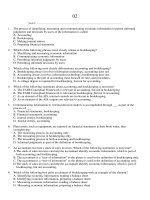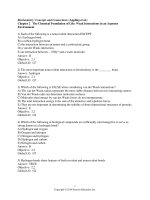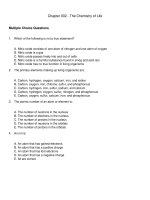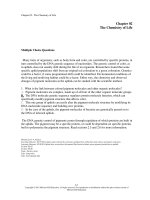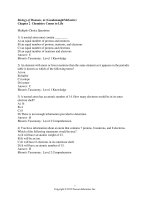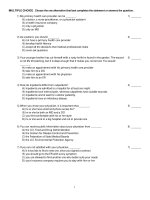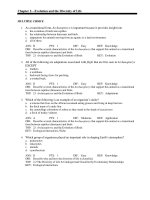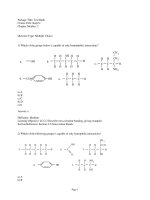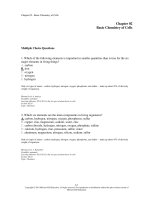Biology concepts and investigations 3rd edition hoefnagels test bank
Bạn đang xem bản rút gọn của tài liệu. Xem và tải ngay bản đầy đủ của tài liệu tại đây (345.82 KB, 43 trang )
Chapter 02 - The Chemistry of Life
Chapter 02
The Chemistry of Life
Multiple Choice Questions
Many traits of organisms, such as body form and color, are controlled by specific proteins, in
turn controlled by the DNA genetic sequence of nucleotides. The genetic control of color, as
in aphids, does not usually shift during the life of an organism. Researchers found that some
specific aphid populations shift from an original red coloration to a green coloration. Genetics
could be a factor, if some programmed shift could be identified. Environmental conditions of
the living and nonliving habitat could be a factor. Either way, the chemistry and observed
changes of pigment molecules in the aphids can be studied with the scientific method.
1. What is the link between colored pigment molecules and other organic molecules?
A. Pigment molecules are complex, made up of all four of the other organic molecule groups.
B. The DNA molecule genetic sequence regulates protein molecule function, which can
specifically modify pigment structure that affects color.
C. This one group of aphids can easily alter the pigment molecule structure by modifying its
DNA nucleotide sequence and building new proteins.
D. In the case of the aphids, the pigment molecules of bacteria are genetically passed on to
the DNA of infected aphids.
The DNA genetic control of pigments comes through regulation of which proteins are built in
the aphids. The pigment may be a specific protein, or could be dependent on specific proteins
built to polymerize the pigment structure. Read sections 2.5 and 2.6 for more information.
Blooms Level: 4. Analyze
Learning Outcome: 02.05.02 Compare and contrast the structures and functions of the four main classes of organic molecules.
Learning Outcome: 02.06.01 Explain how researchers determined that bacteria induce green pigment production in aphids.
Section: 02.05
Section: 02.06
Topic: Nucleic Acids
Type: Integrative
Type: Investigating Life
2-1
Copyright © 2015 McGraw-Hill Education. All rights reserved. No reproduction or distribution without the prior written consent of
McGraw-Hill Education.
Chapter 02 - The Chemistry of Life
2. The initial experiment of Koga and Fugatsu, in testing for any bacterial cause of aphid
color change, involved all of these except
A. a group of red aphids was grown as a control group.
B. the specific amounts of red and green pigment molecules were initially measured as
dependent variables.
C. a group of aphids infected with Rickettsiella bacteria was grown, then killed in order to
produce an extract to test on red aphids.
D. a group of red aphids was treated with the independent variable of Rickettsiella bacteria
infection from green aphids.
E. a group of green aphids was grown, then killed in order to produce an extract to test on red
aphids.
Koga and Fugatsu conducted two distinct studies addressing different aspects of the color
changing aphids. Read section 2.6 for more information (and review the scientific method in
chapter 1).
Blooms Level: 3. Apply
Learning Outcome: 02.06.01 Explain how researchers determined that bacteria induce green pigment production in aphids.
Section: 02.06
Topic: Chemical Bonds
Topic: Nucleic Acids
Type: Investigating Life
2-2
Copyright © 2015 McGraw-Hill Education. All rights reserved. No reproduction or distribution without the prior written consent of
McGraw-Hill Education.
Chapter 02 - The Chemistry of Life
3. The observations and research on aphid color changes can most directly be summarized in
that
A. species of organisms can be chemically diverse and affect each other, even among similar
groups of aphids and bacteria.
B. the method of paper fiber separation of pigment molecules showed that Ricketsiella
bacteria were the source of the green coloration of aphids.
C. it turned out that the green appearance of aphids was because of the large amount of green
Ricketsiella bacteria coating their bodies.
D. Koga and Fugatsu proved that the color change from red to green in aphids was
ecologically favorable to survival.
Two hardest parts of scientific investigation are determining a research question of what is
not yet known, and then drawing useful summary conclusions after research results are
analyzed for value. Read section 2.6 for more perspective on this study (and review the
scientific method in chapter 1).
Blooms Level: 4. Analyze
Learning Outcome: 02.06.01 Explain how researchers determined that bacteria induce green pigment production in aphids.
Section: 02.06
Topic: Chemical Bonds
Topic: Nucleic Acids
Type: Investigating Life
4. Researchers noted that only few aphids changed color to green from their original red. This
is an unusual observation among any animals. What research question came out of the
observations?
A. Is the color shift of certain aphids due to genetics or some other factor?
B. The color shift of certain aphids is due to genetics within the species.
C. Do other aphids change colors as they age?
D. Will green aphids change their color to red, or remain green as they age?
The different steps of the scientific method are demonstrated in the Investigating Life section.
Hypotheses are statements that serve as individual possible answers to a research question.
Read section 2.6 for more information.
Blooms Level: 2. Understand
Learning Outcome: 02.06.01 Explain how researchers determined that bacteria induce green pigment production in aphids.
Section: 02.06
Topic: Nucleic Acids
Type: Investigating Life
2-3
Copyright © 2015 McGraw-Hill Education. All rights reserved. No reproduction or distribution without the prior written consent of
McGraw-Hill Education.
Chapter 02 - The Chemistry of Life
5. A conscientious person habitually reads nutrition labels on food packages for weight
watching and general health. The main nutritional molecules are made up of
A. trace elements.
B. buffers.
C. bulk elements.
D. isotopes.
Carbohydrates, lipids, and proteins, required in reporting on nutrition labels, are organic
molecules composed mainly of carbons, hydrogens, and oxygens. Read sections 2.1.A and
2.5 for more information.
Blooms Level: 2. Understand
Learning Outcome: 02.01.01 Identify the most abundant essential elements in living organisms.
Learning Outcome: 02.05.02 Compare and contrast the structures and functions of the four main classes of organic molecules.
Section: 02.01
Section: 02.05
Topic: Carbohydrate
Topic: Lipids
Topic: Nucleic Acids
Topic: Proteins
Type: Integrative
6. In the 1700s, a French scientist, Antoine Lavoisier gained new experimental information
about how chemistry works. He isolated chemicals that were reacting, including a metal and
an acid. His observation of the results seemed to show that much of the metal had been lost in
the chemical reaction. Yet, upon weighing the system, the total amounts of materials had not
changed during the reaction. His resulting law of Conservation of Mass also applies to
biology, because the materials we are made of are _________ that change forms, but aren't
truly lost as we conduct life chemical reactions.
A. energy
B. matter
C. isotopes
D. solutions
Lavoisier showed that chemical reactions rearrange matter, rather than create or destroy
atoms that make matter. Read section 2.1 for more information on elements, and also sections
2.2.A and 2.2.B for more information.
Blooms Level: 2. Understand
Learning Outcome: 02.00.01 Explain the relationship between chemistry and biology.
Learning Outcome: 02.02.03 Compare and contrast ionic, covalent, and hydrogen bonds.
Section: 02.01
Topic: Atomic Structure
Type: Integrative
2-4
Copyright © 2015 McGraw-Hill Education. All rights reserved. No reproduction or distribution without the prior written consent of
McGraw-Hill Education.
Chapter 02 - The Chemistry of Life
7. The unique properties of water, including its strength as a solvent, its three environmental
stages of solid, liquid, and gas, and its temperature regulation, are a result of
A. unbalanced electronegativity of the hydrogens and oxygens as they share electrons.
B. the imbalance in numbers of electrons around hydrogen and oxygen valence shells after
they ionically bond.
C. the cohesion and adhesion of water molecules that bond more strongly to each other than
other substances.
D. symmetric balance of electronegativity as shared electrons orbit equally around the
hydrogens and oxygens.
The same basic properties of water from its covalent bond and resulting electronegativity
contribute to the importance of all water properties that benefit life. Read sections 2.2.B and
2.3.A through 2.3.D for more information.
Blooms Level: 2. Understand
Learning Outcome: 02.02.03 Compare and contrast ionic, covalent, and hydrogen bonds.
Learning Outcome: 02.02.04 Explain the relationship between electronegativity and chemical bond formation.
Learning Outcome: 02.03.01 Explain how the structure of water affects its chemical properties.
Section: 02.02
Section: 02.03
Topic: Properties of Water
Type: Integrative
2-5
Copyright © 2015 McGraw-Hill Education. All rights reserved. No reproduction or distribution without the prior written consent of
McGraw-Hill Education.
Chapter 02 - The Chemistry of Life
Refer to this diagram with common examples of substances and their pH.
2-6
Copyright © 2015 McGraw-Hill Education. All rights reserved. No reproduction or distribution without the prior written consent of
McGraw-Hill Education.
Chapter 02 - The Chemistry of Life
8. The correct functions of your lungs contribute to the normal pH level of between 7.35 and
7.45. If your lungs do not exchange and remove carbon dioxide from your blood, the blood
pH will change. A pH 6.4 reading of your blood indicates
A. a health problem due to the pH value being 2X higher OH- concentrations than normal in
your body.
B. no health risk, as part of normal pH changes in your body that in this case bring it closer to
neutral pH.
C. a health problem due to the pH value being 2X higher H+ concentrations than normal in
your body.
D. a health problem due to the pH value being 10X higher H+ concentrations than normal in
your body.
E. a health problem due to the pH value being 10X higher OH- concentrations than normal in
your body.
Because the pH scale is logarithmic, every whole number change represents 10X change in
concentrations and reactivity of the solution. Slight changes to the decimal place of pH
change can affect your health. Read section 2.4.A for more information.
Blooms Level: 3. Apply
Figure: 02.14
Learning Outcome: 02.04.01 Explain how acids and bases affect pH.
Section: 02.04
Topic: Acids and Bases
Topic: Properties of Water
2-7
Copyright © 2015 McGraw-Hill Education. All rights reserved. No reproduction or distribution without the prior written consent of
McGraw-Hill Education.
Chapter 02 - The Chemistry of Life
9. Our normal blood pH should be in a fairly narrow range. Imagine you sit down to eat a
large meal with cola, tomato-based sauce, and a salad with many citrus fruit slices. Identify
the one statement that does not apply as one of the likely outcomes of your meal.
A. Your blood and body fluids will likely become more basic, with higher pH than the
normal range.
B. Your blood and body fluids will likely become more acidic, with lower pH than the
normal range.
C. The cola, tomato and citrus fruits will add hydrogen (H+) to your blood and body fluids.
D. Your body will produce buffer molecules to help neutralize acids you ate, so your blood
pH doesn't change much.
There are medical terms for having your blood pH out of the very narrow normal range. Your
meals can have temporary effects on you, that can affect heart, lungs, and other organ
functions, though buffers help in stability. Read sections 2.4.A and 2.4.B for more
information.
Blooms Level: 3. Apply
Figure: 02.14
Learning Outcome: 02.00.01 Explain the relationship between chemistry and biology.
Learning Outcome: 02.04.01 Explain how acids and bases affect pH.
Section: 02.04
Topic: Acids and Bases
Topic: Properties of Water
Type: Integrative
Examine this image of the glucose molecule.
2-8
Copyright © 2015 McGraw-Hill Education. All rights reserved. No reproduction or distribution without the prior written consent of
McGraw-Hill Education.
Chapter 02 - The Chemistry of Life
10. This glucose molecule is a(an)
A. disaccharide.
B. carbohydrate.
C. triglyceride.
D. polymer.
The shapes, structures and sizes of organic molecules are specifically linked to vital cell
functions. Read section 2.5.A for more information.
Blooms Level: 1. Remember
Figure: 02.17
Learning Outcome: 02.05.02 Compare and contrast the structures and functions of the four main classes of organic molecules.
Section: 02.05
Topic: Carbohydrate
11. In our diets, this molecule is often covalently bonded with others in the polymer form of
A. a complex carbohydrate.
B. a simple sugar.
C. a fatty acid chain.
D. a triglyceride.
We typically hear of monomers and polymers regarding "plastics," but organic chemists
learned about these materials by studying organic molecules from life. Read section 2.5.A
for more information.
Blooms Level: 2. Understand
Figure: 02.17
Learning Outcome: 02.05.02 Compare and contrast the structures and functions of the four main classes of organic molecules.
Section: 02.05
Topic: Carbohydrate
2-9
Copyright © 2015 McGraw-Hill Education. All rights reserved. No reproduction or distribution without the prior written consent of
McGraw-Hill Education.
Chapter 02 - The Chemistry of Life
12. Compared with a molecule of glucose, this starch molecule does NOT have which
characteristic below?
A. This molecule is used by cells for long-term storage and release of energy for cell
functions.
B. This molecule is used by cells for quick release of energy for cell functions.
C. This molecule can provide structure for cells that contain it.
D. This molecule is a complex carbohydrate polymer.
Our diets include simple sugars and complex sugars. The uses vary depending on how
simple sugars are bonded to each other in chains. Read section 2.5.A for more information.
Blooms Level: 2. Understand
Figure: 02.17
Learning Outcome: 02.05.02 Compare and contrast the structures and functions of the four main classes of organic molecules.
Section: 02.05
Topic: Carbohydrate
True / False Questions
2-10
Copyright © 2015 McGraw-Hill Education. All rights reserved. No reproduction or distribution without the prior written consent of
McGraw-Hill Education.
Chapter 02 - The Chemistry of Life
Examine these two sugars, as shown prior to the chemical reaction that would bond them.
13. These glucose and fructose molecules will bond to form a monosaccharide with the
removal of water.
FALSE
Formation of new covalent bonds between monomers results in larger, multiple unit
molecules. Read section 2.5 for more information.
Blooms Level: 1. Remember
Figure: 02.17
Learning Outcome: 02.05.02 Compare and contrast the structures and functions of the four main classes of organic molecules.
Section: 02.05
Topic: Carbohydrate
Multiple Choice Questions
2-11
Copyright © 2015 McGraw-Hill Education. All rights reserved. No reproduction or distribution without the prior written consent of
McGraw-Hill Education.
Chapter 02 - The Chemistry of Life
14. The diagram shows glucose and fructose before the chemical reaction called ______
builds a larger polymer from the two monomers.
A. reproduction
B. dehydration synthesis
C. evaporation
D. hydrolysis
Living cells constantly build and tear apart polymers as needed for varying functions.
Covalent bonds are formed and broken with the addition or subtraction of components of
water. Read sections 2.5 and 2.5.A for more information.
Blooms Level: 2. Understand
Figure: 02.17
Learning Outcome: 02.05.01 Differentiate between dehydration synthesis and hydrolysis.
Section: 02.05
Topic: Carbohydrate
Topic: Chemical Bonds
15. The ring structure of glucose indicates that it is a(an)
A. monosaccharide.
B. disaccharide.
C. fatty acid.
D. nucleotide.
E. amino acid.
The single ring structure and the approximate ratio of carbons:hydrogens:oxygens of 1:2:1
indicates the general type of molecule as a unit. Read section 2.5.A for more information.
Blooms Level: 1. Remember
Learning Outcome: 02.05.02 Compare and contrast the structures and functions of the four main classes of organic molecules.
Section: 02.05
Topic: Carbohydrate
Topic: Chemical Bonds
2-12
Copyright © 2015 McGraw-Hill Education. All rights reserved. No reproduction or distribution without the prior written consent of
McGraw-Hill Education.
Chapter 02 - The Chemistry of Life
16. The primary elements making up living organisms are
A. carbon, hydrogen, oxygen, sulfur, nitrogen, and phosphorus.
B. carbon, hydrogen, iron, sulfur, sodium, and calcium.
C. carbon, oxygen, iron, chlorine, sulfur, and phosphorus.
D. carbon, hydrogen, oxygen, calcium, iron, and iodine.
E. carbon, oxygen, sulfur, calcium, iron, and phosphorus.
Bulk elements are often listed on labels of vitamins and food nutrition labels, enforcing the
understanding that they are required for our vital health. They are commonly also needed by
other organisms for their health. Read section 2.1.A for more information.
Blooms Level: 1. Remember
Learning Outcome: 02.01.01 Identify the most abundant essential elements in living organisms.
Section: 02.01
Topic: Atomic Structure
17. The atomic number of an element is the number of
A. protons in the orbitals.
B. electrons in the nucleus.
C. neutrons in the orbitals.
D. neutrons in the nucleus.
E. protons in the nucleus.
Each named element has distinct properties associated with their protons and electrons, and
the periodic table of the elements organizes elements by these components. Read section
2.1.B for more information.
Blooms Level: 1. Remember
Learning Outcome: 02.01.02 Describe the structure of atoms.
Section: 02.01
Topic: Atomic Structure
2-13
Copyright © 2015 McGraw-Hill Education. All rights reserved. No reproduction or distribution without the prior written consent of
McGraw-Hill Education.
Chapter 02 - The Chemistry of Life
18. Given this information from one element in the periodic table of elements, the number of
neutrons and protons is
A.
B.
C.
D.
E.
7, which is the atomic number indicated.
14, which is the atomic number indicated.
7, which is the atomic mass indicated.
not discernable, because the number of electrons is also needed.
14, which is the atomic mass indicated.
The information about elements is reported in standardized form for reference by all
scientists. Read sections 2.1.B and 2.1.C for more information.
Blooms Level: 3. Apply
Learning Outcome: 02.01.02 Describe the structure of atoms.
Section: 02.01
Topic: Atomic Structure
2-14
Copyright © 2015 McGraw-Hill Education. All rights reserved. No reproduction or distribution without the prior written consent of
McGraw-Hill Education.
Chapter 02 - The Chemistry of Life
19. The mass number is defined as the total number of __________ of an atom.
A. protons and neutrons
B. protons
C. protons and electrons
D. neutrons and electrons
E. protons, neutrons, and electrons
Mass number is analyzed and reported, because researchers may need to identify if isotopes
or radioisotopes are present. Read section 2.1.C for more information.
Blooms Level: 1. Remember
Learning Outcome: 02.01.02 Describe the structure of atoms.
Section: 02.01
Topic: Atomic Structure
20. An ion is an atom that has
A. a different number of neutrons from the number of protons.
B. a net negative charge.
C. a net negative or positive charge, with number of electrons different from number of
protons.
D. the same number of electrons as it does protons.
E. a net positive charge.
The elemental form listed in the periodic table of elements assumes a neutral condition,
having electron and proton numbers equal. Read section 2.1.B for more information.
Blooms Level: 2. Understand
Learning Outcome: 02.01.01 Identify the most abundant essential elements in living organisms.
Section: 02.01
Topic: Atomic Structure
2-15
Copyright © 2015 McGraw-Hill Education. All rights reserved. No reproduction or distribution without the prior written consent of
McGraw-Hill Education.
Chapter 02 - The Chemistry of Life
21. The first energy shell of an atom contains a maximum of ________ electron(s).
A. eight
B. sixteen
C. four
D. two
E. one
The numbers of electrons that fill the first energy shell is common to all elements. Read
section 2.2.A for more information.
Blooms Level: 1. Remember
Learning Outcome: 02.02.02 Use the number of valence electrons in an atom to predict the number of bonds it will form.
Section: 02.02
Topic: Atomic Structure
22. An element is found to have atoms with eight electrons in its valence shell. The atoms
will be ____
A. not chemically stable.
B. highly reactive.
C. highly likely to combine with other atoms.
D. chemically stable.
E. not inert.
The stability, or lack of chemical reactivity, is dependent upon whether the valence shell is
full or not, regardless of whether there is a normal atom or an ion. Read sections 2.1.B and
2.2.A for more information.
Blooms Level: 3. Apply
Learning Outcome: 02.01.02 Describe the structure of atoms.
Learning Outcome: 02.02.02 Use the number of valence electrons in an atom to predict the number of bonds it will form.
Section: 02.01
Section: 02.02
Topic: Atomic Structure
Type: Integrative
2-16
Copyright © 2015 McGraw-Hill Education. All rights reserved. No reproduction or distribution without the prior written consent of
McGraw-Hill Education.
Chapter 02 - The Chemistry of Life
23. In a covalent bond, atoms
A. share a proton.
B. share electrons.
C. both become highly electronegative.
D. of opposite charges attract each other.
The outer valence shells can be filled by either 'sharing' or complete 'donation' of electrons.
Read section 2.2.B for more information.
Blooms Level: 1. Remember
Learning Outcome: 02.02.03 Compare and contrast ionic, covalent, and hydrogen bonds.
Section: 02.02
Topic: Chemical Bonds
24. In an ionic bond,
A. atoms, having gained or lost electrons, attract one another with opposite charges.
B. two atoms are attracted by partial positive and negative charges.
C. atoms attract each other by sharing electrons to fill their valence shells.
D. two atoms both become strongly electronegative and attract each other.
The outer valence shells can be filled by either 'sharing' or complete 'donation' of electrons.
The positive and negative charges are due to complete gains or losses of electrons, changing
the charge balance with protons. Read section 2.2.C for more information.
Blooms Level: 1. Remember
Learning Outcome: 02.02.03 Compare and contrast ionic, covalent, and hydrogen bonds.
Section: 02.02
Topic: Chemical Bonds
2-17
Copyright © 2015 McGraw-Hill Education. All rights reserved. No reproduction or distribution without the prior written consent of
McGraw-Hill Education.
Chapter 02 - The Chemistry of Life
25. Carbon and hydrogen make up many biologically important molecules. Carbon has an
electronegativity of 2.55 while hydrogen has an electronegativity of 2.0. On the scale of
electronegativity from zero (0) to four (4), the carbon and hydrogens shown here have just
formed
A.
B.
C.
D.
an ionic bond.
a nonpolar covalent bond.
a polar covalent bond.
a hydrogen bond.
Electronegativity will impact the distribution of where atoms spend most time while shared
in covalent bonds. Read section 2.2.B for more information.
Blooms Level: 4. Analyze
Figure: 02.07
Learning Outcome: 02.02.03 Compare and contrast ionic, covalent, and hydrogen bonds.
Learning Outcome: 02.02.04 Explain the relationship between electronegativity and chemical bond formation.
Section: 02.02
Topic: Chemical Bonds
Type: Integrative
2-18
Copyright © 2015 McGraw-Hill Education. All rights reserved. No reproduction or distribution without the prior written consent of
McGraw-Hill Education.
Chapter 02 - The Chemistry of Life
26. Which statement summarizes the distinction between nonpolar and polar covalent bonds?
A. The difference in electronegativity of the atoms in a nonpolar covalent bond is very large.
B. Polar covalent bonds are formed when the atoms gain or lose electrons to bond, and
become oppositely charged ions.
C. The electrons are more evenly and symmetrically distributed in orbit among atoms in a
nonpolar covalent bond.
D. The electrons are more evenly and symmetrically distributed in orbit among atoms in a
polar covalent bond.
Covalent bonds require sharing of electrons, though the time electrons spend in orbit around
each atom will vary. Read section 2.2.B for more information.
Blooms Level: 2. Understand
Learning Outcome: 02.02.03 Compare and contrast ionic, covalent, and hydrogen bonds.
Learning Outcome: 02.02.04 Explain the relationship between electronegativity and chemical bond formation.
Section: 02.02
Topic: Chemical Bonds
2-19
Copyright © 2015 McGraw-Hill Education. All rights reserved. No reproduction or distribution without the prior written consent of
McGraw-Hill Education.
Chapter 02 - The Chemistry of Life
27. In the example of ionic bond formation between sodium and chlorine, as shown, which of
the following is not a true statement?
A.
B.
C.
D.
E.
Sodium donates an electron.
Sodium becomes positively charged.
The bond that is formed is stronger than a hydrogen bond.
Na is the chemical symbol for sodium.
Chlorine donates an electron.
The donation, or loss of the electron from sodium (Na) is shown, forming it into an ion. The
gain of the electron by chlorine (Cl) forms it into an ion. Read section 2.2.C for more
information.
Blooms Level: 1. Remember
Figure: 02.06
Learning Outcome: 02.02.03 Compare and contrast ionic, covalent, and hydrogen bonds.
Section: 02.02
Topic: Chemical Bonds
2-20
Copyright © 2015 McGraw-Hill Education. All rights reserved. No reproduction or distribution without the prior written consent of
McGraw-Hill Education.
Chapter 02 - The Chemistry of Life
28. The chapter concept map links covalent and ionic bonds as chemical bonds that attract
atoms or molecules. What is the chemical bond characteristic that contributes to the
numerous important properties of water molecules for living organisms?
A. The covalent bond strengths of water molecules change with pH, temperature, or solute
conditions present.
B. The covalent bonds that form water molecules transform to ionic bonds in presence of
other molecules, temperature changes, or pH.
C. Hydrogen bonds form between water molecules, not requiring gain, loss, or sharing of
electrons.
D. Bonds that form water are of the nonpolar covalent form.
Hydrogen bonds between water molecules provide "flexibility" in distances and angles
between the water molecules without gain, loss, or sharing of electrons. This contributes to
the numerous important properties of water. Read sections 2.2.D and 2.3 for more
information.
Blooms Level: 2. Understand
Learning Outcome: 02.02.03 Compare and contrast ionic, covalent, and hydrogen bonds.
Learning Outcome: 02.03.01 Explain how the structure of water affects its chemical properties.
Section: 02.02
Section: 02.03
Topic: Chemical Bonds
Type: Integrative
True / False Questions
2-21
Copyright © 2015 McGraw-Hill Education. All rights reserved. No reproduction or distribution without the prior written consent of
McGraw-Hill Education.
Chapter 02 - The Chemistry of Life
29. The property of water demonstrated by this water strider, as it remains on top of the
water, is that water is a universal solvent.
FALSE
Water's partial charges allow it to be cohesive, so that the surface tension among molecules
can support this light insect. Read section 2.3.A for more information.
2-22
Copyright © 2015 McGraw-Hill Education. All rights reserved. No reproduction or distribution without the prior written consent of
McGraw-Hill Education.
Chapter 02 - The Chemistry of Life
Blooms Level: 1. Remember
Figure: 02.10
Learning Outcome: 02.03.01 Explain how the structure of water affects its chemical properties.
Section: 02.03
Topic: Chemical Bonds
Multiple Choice Questions
30. You can painlessly wade into a pool, but doing a belly flop off of the high diving board
hurts because of
A. water's high boiling point.
B. cohesion in water.
C. water's high density.
D. adhesion in water.
E. water's neutral pH.
Though individually small, water molecules form hydrogen bonds with each other to produce
surface conditions we experience differently depending on how we enter the water. Read
section 2.3.A for more information.
Blooms Level: 3. Apply
Learning Outcome: 02.02.03 Compare and contrast ionic, covalent, and hydrogen bonds.
Learning Outcome: 02.03.01 Explain how the structure of water affects its chemical properties.
Section: 02.02
Section: 02.03
Topic: Chemical Bonds
Topic: Properties of Water
Type: Integrative
2-23
Copyright © 2015 McGraw-Hill Education. All rights reserved. No reproduction or distribution without the prior written consent of
McGraw-Hill Education.
Chapter 02 - The Chemistry of Life
31. Trees are able to transport water from the roots to the top branches because
A. water acts as a solvent of the tree cells as it moves upwards to the branches.
B. liquid water has a higher density than the air in the plant cells of the roots, trunk and
branches.
C. adhesion bonds water molecules to the insides of the plant cells.
D. cohesion bonds water molecules to each other strongly.
The partial hydrogen bond charges between water molecules and the molecules of tree cells
help the water move large distances. Read section 2.3.A for more information.
Blooms Level: 1. Remember
Learning Outcome: 02.02.03 Compare and contrast ionic, covalent, and hydrogen bonds.
Learning Outcome: 02.03.01 Explain how the structure of water affects its chemical properties.
Section: 02.03
Topic: Chemical Bonds
Topic: Properties of Water
2-24
Copyright © 2015 McGraw-Hill Education. All rights reserved. No reproduction or distribution without the prior written consent of
McGraw-Hill Education.
Chapter 02 - The Chemistry of Life
32. Within a single molecule of water, as shown, ____ bonds are formed between oxygen and
hydrogen.
A.
B.
C.
D.
E.
hydrophobic
ionic
hydrogen
nuclear
covalent
As the diagram shows, the oxygen and hydrogens share orbits of electrons in their valence
shells. Read section 2.2.B for more information.
Blooms Level: 1. Remember
Figure: 02.07
Learning Outcome: 02.02.03 Compare and contrast ionic, covalent, and hydrogen bonds.
Section: 02.02
Topic: Atomic Structure
Topic: Chemical Bonds
Topic: Properties of Water
True / False Questions
2-25
Copyright © 2015 McGraw-Hill Education. All rights reserved. No reproduction or distribution without the prior written consent of
McGraw-Hill Education.
